Not all Voltage Stabiliser solutions are designed or built the same!
For the lay person, differentiating between the numerous suppliers and various design technologies utilised to deliver voltage stabilisation can often be a daunting task and it is not always clear as to which technology is best for a particular application.
As one of the world’s leading specialist ‘Quality’ manufacturers and suppliers of Voltage Stabilisers and associated Power Line Conditioning solutions we offer probably the widest choice and cross section of alternative design types and models.
Below we discuss the various design topologies available in today’s market and highlight the advantages, disadvantages and most appropriate application for each topology
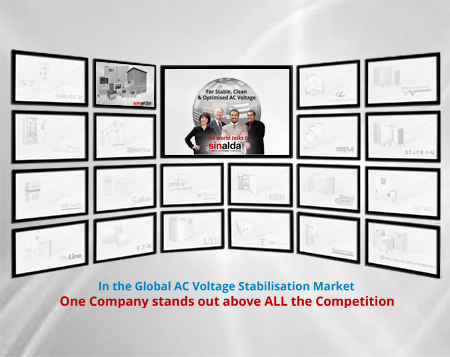
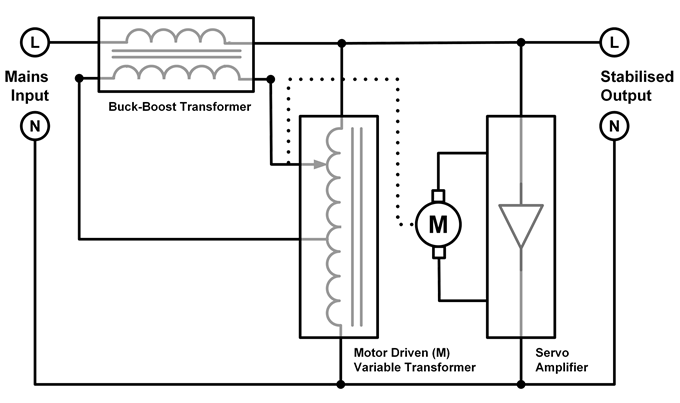 Design Overview Being able to accommodate an input voltage swing of in excess of 40%, whilst still capable of delivering accuracy on the output of 1% or better, the Servo Electronic design principle comprises a transformer having its secondary winding connected between the mains supply and the load. The primary voltage is automatically controlled through a servo motor driven variable transformer, thereby ensuring a continuous, smooth and very stable output voltage. A solid state Servo-Amplifier continuously monitors the output voltage of the stabiliser. Should, due to an incoming voltage or load current change, the output voltage deviate from the required value, the Amplifier sensor instructs the servo motor to rotate the brush-gear on the variable transformer to correct the output for the deviation. The speed of detection and actions of the servo system are exceptionally fast, with controlled motor deceleration to minimise any possibility of overshoot.
Design Overview Being able to accommodate an input voltage swing of in excess of 40%, whilst still capable of delivering accuracy on the output of 1% or better, the Servo Electronic design principle comprises a transformer having its secondary winding connected between the mains supply and the load. The primary voltage is automatically controlled through a servo motor driven variable transformer, thereby ensuring a continuous, smooth and very stable output voltage. A solid state Servo-Amplifier continuously monitors the output voltage of the stabiliser. Should, due to an incoming voltage or load current change, the output voltage deviate from the required value, the Amplifier sensor instructs the servo motor to rotate the brush-gear on the variable transformer to correct the output for the deviation. The speed of detection and actions of the servo system are exceptionally fast, with controlled motor deceleration to minimise any possibility of overshoot.Design Advantages
- Size and weight advantages over other methods of stabilisation
- Fast speed of response to voltage changes – ideal for 95% of all applications
- Very competitively priced
- Negligible output waveform distortion
- Not Frequency dependent
- Will attenuate voltage spikes (if required)
- Unaffected by load or power factor changes
- Low cost of ownership with ease of serviceability
- Endurable with long life expectancy
Design Disadvantages
- Moving parts requiring a certain amount of limited maintenance
- Lower speed of response in comparison to the more costly solid state design topology solutions
Summary:
Sinalda UK Servo Electronic based Solutions
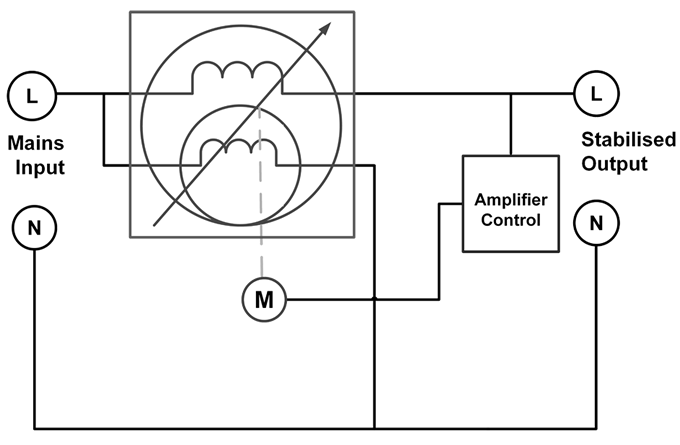 Design Overview Magnetic Induction based solutions, utilise a simple, yet highly reliable, rotor and stator design principle to increase or reduce the magnitude of the voltage in a series transformer winding, thereby delivering and maintaining a constant output voltage. The arrangement is similar to a motor, except that the rotor does not rotate continuously. Its maximum rotation is only 130 degrees. The magnetic coupling between the rotor (the shunt winding) and stator (series winding) will cause the magnitude of the voltage in the series winding to increase or decrease, depending on the angle or position of the rotor to the stator. For example, when the input voltage drops, the rotor will rotate clockwise to such an angle to make up for the drop in voltage, rotating anti-clockwise to correct for a high voltage.
Design Overview Magnetic Induction based solutions, utilise a simple, yet highly reliable, rotor and stator design principle to increase or reduce the magnitude of the voltage in a series transformer winding, thereby delivering and maintaining a constant output voltage. The arrangement is similar to a motor, except that the rotor does not rotate continuously. Its maximum rotation is only 130 degrees. The magnetic coupling between the rotor (the shunt winding) and stator (series winding) will cause the magnitude of the voltage in the series winding to increase or decrease, depending on the angle or position of the rotor to the stator. For example, when the input voltage drops, the rotor will rotate clockwise to such an angle to make up for the drop in voltage, rotating anti-clockwise to correct for a high voltage.Design Advantages
- Brushless - virtually Maintenance Free with no contact wear or requirement for carbon brush replacement.
- Highly reliable, efficient and robust design – ideal for the tougher style industrial applications
- Oil Cooling Option - delivers smaller physical size and makes the topology ideal for applications in more humid environments
Design Disadvantages
- Usually less price competitive when compared to servo electronic design based systems
Summary:
Sinalda UK Three Phase Magnetic Induction based Solutions
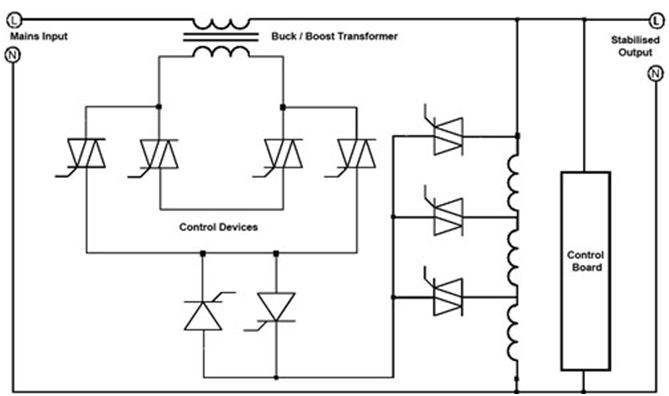 Design Overview This is a similar circuit arrangement to the Servo Design method of Voltage Stabilisation except that Triacs or Thyristors (dependent upon Stabiliser capacity) are used to select the appropriate voltage from a series of voltage taps on a transformer to feed the primary of a Buck/Boost Transformer instead of using a motor-driven Variable Transformer. By using microprocessor control the Triacs / Thyristors can be switched at the zero- crossover point of the voltage waveform thus eradicating any switching distortion caused by phase-controlled devices. Dependent upon the input voltage window that needs to be controlled output voltage accuracies of 1% can be achieved. Output Voltage control is achieved by sequential steps to provide a similar control to that of the motorised Variable Transformer servo system.
Design Overview This is a similar circuit arrangement to the Servo Design method of Voltage Stabilisation except that Triacs or Thyristors (dependent upon Stabiliser capacity) are used to select the appropriate voltage from a series of voltage taps on a transformer to feed the primary of a Buck/Boost Transformer instead of using a motor-driven Variable Transformer. By using microprocessor control the Triacs / Thyristors can be switched at the zero- crossover point of the voltage waveform thus eradicating any switching distortion caused by phase-controlled devices. Dependent upon the input voltage window that needs to be controlled output voltage accuracies of 1% can be achieved. Output Voltage control is achieved by sequential steps to provide a similar control to that of the motorised Variable Transformer servo system.Design Advantages
- Not restricted in Stabiliser Capacity as there is no requirement for large motorised Variable Transformers.
- Solid State - no moving parts, virtually maintenance-free.
- Low/simple maintenance - just fans and general cleaning required.
- High Efficiency
- Cost-effective especially on larger kVA ratings.
- Negligible Output Waveform Distortion.
Design Disadvantages
- Output Voltage accuracy deteriorates to ±5% on large input voltage swings (>±30%)
Summary:
Sinalda UK based Solutions
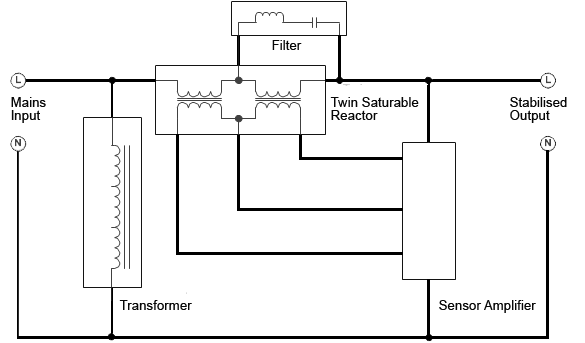 Design Overview An ‘Aiding’ and ‘Opposing’ Magnetic Amplifier is connected across the main transformer to either increase or reduce the input voltage should it go high or low. This is achieved by increasing or reducing the magnetic inductance in the two cores. The Control Amplifier Sensor will detect the input fluctuations and then inject a DC current into the two respective amplifiers to either increase or reduce its inductance. Reducing the inductance will increase or reduce the output voltage and vice versa. The Sensing Amplifier monitors the output voltage continuously and automatically adjusts the DC currents through the control coils, thereby ensuring that the output voltage is kept constant. The Filter, in conjunction with the inductance of the magnetic core, forms an extremely effective means of suppressing high energy spikes and other mains borne noise.
Design Overview An ‘Aiding’ and ‘Opposing’ Magnetic Amplifier is connected across the main transformer to either increase or reduce the input voltage should it go high or low. This is achieved by increasing or reducing the magnetic inductance in the two cores. The Control Amplifier Sensor will detect the input fluctuations and then inject a DC current into the two respective amplifiers to either increase or reduce its inductance. Reducing the inductance will increase or reduce the output voltage and vice versa. The Sensing Amplifier monitors the output voltage continuously and automatically adjusts the DC currents through the control coils, thereby ensuring that the output voltage is kept constant. The Filter, in conjunction with the inductance of the magnetic core, forms an extremely effective means of suppressing high energy spikes and other mains borne noise.Design Advantages
- Solid State – with no moving parts – virtually Maintenance Free
- Ultra-fast speed of response to voltage changes
- Extremely accurate output voltage - accuracy better than 1%, typically 0.5%
Design Disadvantages
- Less price competitive when compared to servo electronic design based systems
- High weight to kVA ratio compared to servo electronic designs
Summary:
Sinalda UK Saturable Reactor based Solutions
Given the extremely high cost of these type Stabilisers, and given the advances made in recent years in the design of Static Electronic solutions, Sinalda UK no longer offers Saturable Reactor based solutions.
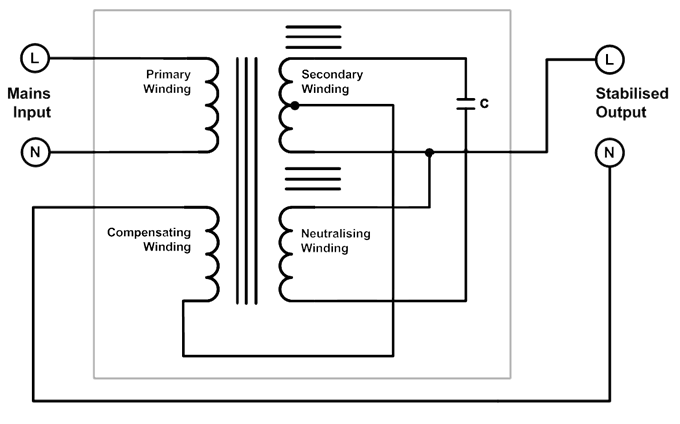 Design Overview Ferro-Resonant / Constant Voltage Transformer (CVT) based solutions, utilise a tank circuit composed of a high-voltage resonant winding and a capacitor to produce a constant output voltage whilst supporting a varying load current - even in situations where the input voltage varies widely. The circuit has a primary on one side of a magnet shunt and tuned circuit coil and a secondary on the other side. Voltage regulation is achieved through the magnetic saturation in the section around the secondary. The design offers excellent isolation – delivering exceptional transient voltage surge suppression and short-circuit protection.
Design Overview Ferro-Resonant / Constant Voltage Transformer (CVT) based solutions, utilise a tank circuit composed of a high-voltage resonant winding and a capacitor to produce a constant output voltage whilst supporting a varying load current - even in situations where the input voltage varies widely. The circuit has a primary on one side of a magnet shunt and tuned circuit coil and a secondary on the other side. Voltage regulation is achieved through the magnetic saturation in the section around the secondary. The design offers excellent isolation – delivering exceptional transient voltage surge suppression and short-circuit protection. Design Advantages
- High speed of response to voltage changes
- Highly dependable Output voltage - voltage does not collapse on high overload or severe input voltage drop
- Solid State - No moving parts and virtually maintenance free.
- Competitively priced - especially for ratings of 5 kVA or below, where the nominal input voltage can vary widely
- Inherent ride-through capability - ensuring that in the event of a short break of up to 3 milli-seconds in duration output is maintained.
- Highly reliable -with extremely high MTBF performance
Design Disadvantages
- Not generally price competitive in ratings above 10 kVA
- High weight to kVA ratio compared to servo electronic designs
- Frequency Dependent - not ideal for applications where severe frequency variations are an issue
- Not the quietest - due to magnetostriction there is a tendency for slight transformer hum and a result it is normally best practice not to install too close an employee’s workstation or audio recording equipment
